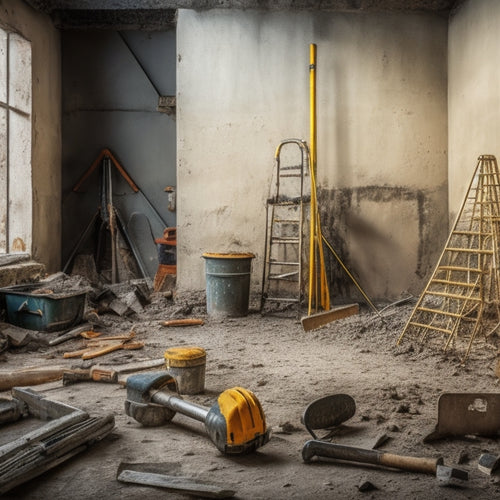
Deck Renovation Tool Checklist by Deck Size
Share
When tackling a deck renovation, you'll need a tailored tool checklist that adapts to your deck's size and complexity. For smaller decks, focus on basic tools like tape measures, levels, and cordless drills. Medium decks require additional tools for assessment, material selection, and design evaluations. Larger decks necessitate calculations for material quantities, structural integrity, and building codes compliance. Extra large decks demand careful planning for material identification, design complexity, and support planning. By understanding deck size and tool correlation, you can guarantee a successful renovation - and to get it right, you'll want to evaluate every detail of your project.
Key Takeaways
• A deck renovation tool checklist varies by deck size, with smaller decks requiring basic hand tools and larger decks needing more specialized equipment.
• The tool checklist should include general tool essentials, disassembly and reassembly tools, cutting tools, power tools, and surface preparation tools.
• Larger decks require more material handling equipment, labor, and site preparation, while smaller decks need more precise power tools and lighter labor requirements.
• Custom deck designs require design-specific tools, material considerations, and feature accommodations, which should be assessed early in the renovation process.
• A deck renovation tool checklist should also consider safety gear, deck block quantity calculations, and regulatory compliance to ensure a successful and safe project.
Small Deck Tool Essentials
You'll need a set of fundamental tools within arm's reach to tackle small deck renovation projects efficiently. This arsenal will help you complete tasks quickly and guarantee your deck maintenance tips are on point.
Start with essential tools like a tape measure, level, and carpenter's square to assure accurate measurements and alignment. A pry bar, hammer, and screwdriver set will help you disassemble and reassemble deck components.
Don't forget a utility knife and wire cutters for cutting and stripping wire. A cordless drill and impact driver will make quick work of screwing and unscrewing deck boards.
Rounding out your kit, add a putty knife, sandpaper, and a broom to clean and prepare deck surfaces. With these tools at your disposal, you'll be well-equipped to tackle small deck projects, from replacing rotted boards to applying a fresh coat of sealant.
Medium Deck Project Requirements
As you move on to medium-sized deck projects, you'll need to tackle more complex tasks, such as repairing the deck frame and selecting the right railing materials.
These tasks require a bit more expertise and specialized tools to get the job done correctly.
You'll need to assess the condition of your deck's frame and choose railing materials that meet local building codes and fit your design vision.
Deck Frame Repair
Prior to rebuilding or resurfacing your deck, inspect the frame for signs of damage, rot, or decay, and plan to repair or replace any compromised components to assure a sturdy foundation for your renovation project. A sturdy frame is vital for deck stability, and using the right frame materials can guarantee your deck lasts for years to come.
Here's a breakdown of common deck frame issues and their solutions:
| Issue | Cause | Solution |
|---|---|---|
| Rotted wood | Moisture exposure | Replace with pressure-treated or composite lumber |
| Loose connections | Worn-out screws or nails | Replace with new, galvanized fasteners |
| Sagging beams | Overloading or poor design | Add additional support beams or replace with stronger materials |
| Corroded metal | Exposure to elements | Replace with stainless steel or galvanized metal components |
| Pest damage | Termite or carpenter ant infestation | Treat with insecticides and replace damaged wood |
Railing Material Options
Two primary railing material options dominate the deck renovation market: wood and metal, each offering distinct advantages and disadvantages that must be carefully weighed for your medium-sized deck project.
Wood railings, a traditional favorite, provide a warm, natural aesthetic and can be stained or painted to match your deck's design. However, they're more prone to rot, warping, and insect damage, requiring regular maintenance.
Metal railings, on the other hand, offer durability, low maintenance, and modern sleekness, but can be noisy, cold to the touch, and may rust if not properly coated.
When selecting a railing material, consider current railing design trends, such as the use of cable or glass panels for a sleek, modern look.
Also, keep in mind railing installation tips, like ensuring proper post spacing and secure attachment to the deck frame.
For a medium-sized deck project, metal railings may be a more cost-effective option, while wood railings can add a touch of elegance.
Ultimately, your railing material choice will depend on your budget, personal style, and deck functionality.
Large Deck Building Calculations
When tackling a large deck renovation, you'll need to calculate the quantities of materials required, guaranteeing you have enough lumber, fasteners, and other essentials to complete the project.
You'll also need to determine the framing requirements, including the size and spacing of beams and joists, to make certain your deck can support the intended load.
Deck Material Quantities
How many deck boards, posts, and footings will you need to complete your large deck project? Calculating deck material quantities is essential to guarantee you have enough materials to complete your project on time and within budget.
To get started, you'll need to determine the total square footage of your deck. From there, you can calculate the number of deck boards, posts, and footings required. Here are some key quantities to take into account:
-
Deck Boards: Calculate the total linear footage of deck boards needed, taking into account the deck's length, width, and any obstructions.
-
Posts: Determine the number of posts required, based on the deck's size and local building codes.
-
Footings: Calculate the number of footings needed, considering the deck's size, soil type, and local building codes.
- Fasteners: Calculate the number of screws, nails, or other fasteners required to secure the deck boards and posts.
When selecting deck material types, take into account factors such as durability, maintenance, and cost. Deck material costs can vary greatly depending on the type and quality of materials chosen.
Deck Framing Requirements
You'll need to determine the deck's joist spacing, beam size, and post placement to guarantee a sturdy deck frame that can support the weight of people, furniture, and additional features like built-in seating or planters.
For large decks, it's crucial to choose the right deck framing materials, such as pressure-treated lumber, composite materials, or naturally rot-resistant woods like cedar or redwood.
Consider the framing layout considerations, including the deck's shape, size, and location, to make sure the frame can withstand various loads and stresses.
When planning the deck's frame, consider the International Residential Code (IRC) and local building codes, which provide guidelines for deck construction.
These codes specify requirements for joist spacing, beam size, and post placement to make sure the deck can support a minimum of 50 pounds per square foot.
Additionally, consider factors like wind loads, snow loads, and soil conditions, which can impact the deck's structural integrity.
Structural Component Calculations
To guarantee your deck's frame can support the intended loads, you need to perform structural component calculations. This involves determining the required sizes and quantities of beams, joists, and posts based on the deck's design and local building codes.
This is vital to confirm the structural integrity of your deck, as inadequate calculations can lead to catastrophic failures.
Here are the key calculations you need to perform:
-
Dead load calculations: Calculate the weight of the deck itself, including the decking material, railings, and other features.
-
Live load calculations: Calculate the weight of people, furniture, and other objects that will be placed on the deck.
-
Wind load calculations: Calculate the force of wind on the deck, taking into account local wind speed and direction.
- Snow load calculations: Calculate the weight of snow and ice that may accumulate on the deck in areas with heavy snowfall.
Extra Large Deck Materials Needed
Large-scale deck renovations require careful planning, and that starts with identifying the extra large deck materials needed to bring your vision to life.
As you're designing your deck, you'll need to reflect on the unique deck design considerations that come with building an extra large deck. For instance, you'll need to think about the structural integrity of your deck, including the size and type of support beams, joists, and footings required to support the weight of the deck and its users.
When it comes to extra large deck features, you'll need to plan for additional materials to accommodate the increased size. This may include longer or wider deck boards, more robust railing systems, and increased quantities of fasteners and flashing.
You'll also need to contemplate the type and quantity of decking material, such as composite, wood, or metal, and how it will be secured to the underlying structure.
Calculating Deck Block Quantity
When building an extra large deck, accurately calculating deck block quantity is essential to guarantee a sturdy foundation and prevent costly mistakes. You can't afford to underestimate the number of blocks needed, as this can lead to a weak structure that puts people's safety at risk. To get it right, you'll need to take into account several factors, including the deck's size, shape, and support requirements.
Here are the key considerations for block quantity estimation:
-
Deck size and shape: Larger decks require more blocks, while irregular shapes may need additional blocks for support.
-
Deck support requirements: You'll need to determine the number of support posts and footings needed, which will impact block quantity.
-
Soil type and condition: Soft or unstable soil may require more blocks for added support.
- Local building codes and regulations: Check with your local authorities to ensure you're meeting all necessary building codes and regulations.
Tool Checklist for Deck Resurfacing
As you prepare to resurface your deck, gathering the right tools is essential to guaranteeing a successful project, and having an extensive checklist will help you get started efficiently.
You'll need to assess your deck's condition to determine the best resurfacing techniques for the job. This may involve removing old decking material, inspecting the underlying structure, and making repairs as needed.
Your tool checklist for deck resurfacing should include:
-
Safety gear: hard hat, safety glasses, gloves, and a dust mask
-
Demolition tools: pry bars, hammers, and a reciprocating saw
-
Inspecting and measuring tools: tape measure, level, and a deck inspection kit
-
Repair and installation tools: drill, impact driver, and a socket set
-
Fastening tools: nails, screws, and a nail gun or screwdriver
-
Cleaning and finishing tools: broom, pressure washer, and a finish applicator
Remember to prioritize tool maintenance, checking your tools regularly to guarantee they're in good working condition.
This will help prevent delays and guarantee a smooth resurfacing process. By having the right tools and a solid plan, you'll be well on your way to a beautifully resurfaced deck.
Deck Size and Tool Correlation
You'll need to adjust your tool selection and strategy based on the size of your deck, since a smaller deck may require more precision and finesse, while a larger deck demands more heavy-duty equipment and labor. The deck size impacts the type of tools you'll need, and ultimately, tool efficiency.
To guarantee a successful renovation, consider the following key factors correlated to deck size:
-
Material handling: Larger decks require more materials, which means you'll need equipment to handle bulk quantities efficiently.
-
Power tool selection: Smaller decks may necessitate lighter, more agile power tools, while larger decks call for heavy-duty, high-torque equipment.
-
Labor requirements: The larger the deck, the more laborers you'll need to complete the job efficiently.
- Site preparation: Larger decks often require more extensive site preparation, including heavy machinery for excavation and grading.
Custom Deck Tool Requirements
Considering the unique features and design elements of your custom deck, you'll need to tailor your tool selection to accommodate specific requirements, such as curved railings, built-in seating, or intricate woodwork. Custom design considerations will influence your tool choices, so it's crucial to identify these elements early on. For instance, if you're incorporating curved railings, you'll need a jigsaw or a bandsaw to make precise cuts.
When it comes to material selection tips, you'll want to choose tools that can effectively work with your chosen materials. For example, if you're using hardwoods, you may need a drill press with a robust motor to handle the density of the wood. Similarly, if you're working with composites, you'll want to select tools that can efficiently cut and shape these materials.
Take the time to assess your custom deck's unique requirements and adjust your tool selection accordingly. This will guarantee that you're well-equipped to tackle the project and achieve the desired results. By considering the custom design elements and material selection, you'll be able to create a stunning deck that meets your vision and exceeds your expectations.
Frequently Asked Questions
Can I Use a Cordless Drill for Deck Renovation Projects?
You're wondering if a cordless drill is suitable for deck renovation projects. The answer is yes, but consider the advantages and limitations.
Cordless drills offer convenience, portability, and reduced cord clutter.
However, battery life is a vital factor - you don't want to run out of power mid-project.
Choose a drill with a high-capacity battery and consider a backup to guarantee continuous work.
Are Deck Screws Rust-Resistant in Coastal Areas?
When renovating a deck in coastal areas, you'll want to make certain your deck screws can withstand the harsh marine environment.
Look for screws made from corrosion-resistant materials, such as stainless steel or coated with a rust-inhibiting finish.
During deck material selection, prioritize screws with enhanced corrosion resistance to prevent premature degradation.
This will assure a durable and long-lasting deck that can withstand the salty air and moisture.
Do I Need a Permit to Renovate My Existing Deck?
Did you know that nearly 40% of deck collapses occur due to improper construction or renovation?
To avoid being part of this statistic, you'll need to navigate deck renovation regulations in your area.
Before starting your project, you'll likely need a permit, which involves a permit application process that includes submitting plans, paying fees, and passing inspections.
You'll want to check with your local government to determine the specific requirements for your deck renovation.
Can I Reuse Old Deck Boards During Renovation?
When renovating, you'll need to assess your existing deck boards to determine if they're reusable.
Inspect the boards for rot, cracks, or water damage. If they're in decent shape, you might be able to reuse them, especially if they're durable deck board types like composite or hardwood.
However, if you're using new renovation techniques, like switching to a different deck board material, it's often better to start fresh to guarantee a sturdy and long-lasting deck.
How Often Should I Inspect My Deck for Maintenance?
You should inspect your deck regularly to prevent safety hazards and costly repairs.
Aim for a deck inspection frequency of every 6-12 months, or more often if you live in an area with harsh weather conditions.
Seasonal maintenance tips include checking for rot, cracks, and loose boards in spring,
cleaning and sealing in summer,
and preparing for winter with waterproofing and covering.
Conclusion
Precise planning pays off when tackling a deck renovation.
By pairing the perfect tools with your project's proportions, you'll pave the way for a proficient process.
From small to extra large, each deck size demands deliberate deliberation.
Don't let inadequate instruments impede your progress.
Instead, carefully calculate your needs, and confidently conquer your deck renovation, ensuring a sturdy, stunning sanctuary that stands the test of time.
Related Posts
-

Affordable Plastering Tools for Home Renovation Success
You're taking the first step towards a successful home renovation by investing in the right plastering tools. Start w...
-

What Tools to Rent for Block Wall Renovation
When renovating a block wall, it's vital to have the right tools for the job. You'll need demolition tools like pry b...
-

3 Best Planter Shopping Timeline Tips for Renovators
When incorporating planters into your renovation project, you'll want to plan carefully to avoid delays and guarantee...


